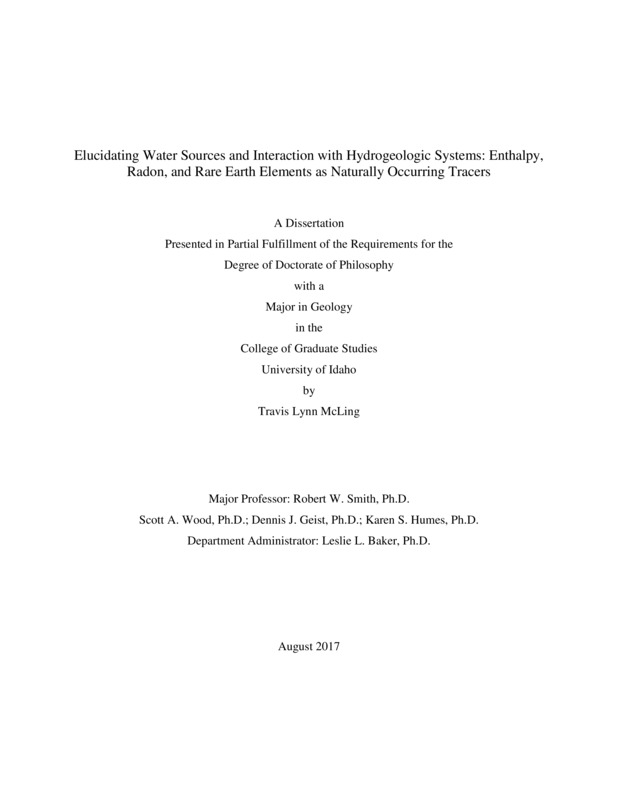Elucidating Water Sources and Interaction with Hydrogeologic Systems: Enthalpy, Radon, and Rare Earth Elements as Naturally Occurring Tracers
McLing, Travis Lynn. (2017). Elucidating Water Sources and Interaction with Hydrogeologic Systems: Enthalpy, Radon, and Rare Earth Elements as Naturally Occurring Tracers. Theses and Dissertations Collection, University of Idaho Library Digital Collections. https://www.lib.uidaho.edu/digital/etd/items/mcling_idaho_0089e_11122.html
- Title:
- Elucidating Water Sources and Interaction with Hydrogeologic Systems: Enthalpy, Radon, and Rare Earth Elements as Naturally Occurring Tracers
- Author:
- McLing, Travis Lynn
- Date:
- 2017
- Keywords:
- geology Hydrochemistry Tracers
- Program:
- Geology
- Subject Category:
- Geochemistry
- Abstract:
-
Presented are three studies that utilize three natural tracers (enthalpy, radon gas, and rare earth elements) to characterize hydrologic systems at three different scales. The scale of investigation ranges from 27,900 km2 for the Eastern Snake River Plain (ESRP) regional aquifer to 0.34 km2 for Shepley’s Hill in West Central Massachusetts. In the first study, we use aquifer temperature and wellbore temperature profiles from the ESRP in an integrated effort to trace regional groundwater flow and aquifer thickness and identify zones of elevated geothermal potential under the ESRP. Understanding the hydrologic conditions of the ESRP aquifer is important to the residents of Eastern Idaho, as it is a soul source aquifer for the region. In our second application of natural tracers, we utilize 222Rn to detect fluid-flow pathways in a fractured-rock-hosted vadose zone at Fort Devens, Massachusetts. The vadose zone is believed to be the source of meteoric water infiltrating a contaminated aquifer that underlies a contaminated landfill. Understanding the source of the meteoric water that flows into the contaminated aquifer is an important part of remediation of the contaminated site. Finally, we investigate and test procedures to preconcentrate trace rare earth elements (REEs) to improve detection by ICP-MS and apply these techniques to characterize a leaking CO2 system in Soda Springs, Idaho. Here, we use groundwater REE chemistry as a tracer to track CO2-charged waters at a natural carbon capture and storage (CCS) analogue site. At this site, naturally leaking CO2 and associated brines from depth is migrating into a shallow aquifer. These studies conducted at widely varying scales and using different tracers demonstrate the usefulness of natural tracers to elucidate conditions in the subsurface that cannot be directly measured by anthropogenic tracers.
- Description:
- doctoral, Ph.D., Geology -- University of Idaho - College of Graduate Studies, 2017
- Major Professor:
- Smith, Robert W
- Committee:
- Humes, Karen; Wood, Scott A; Geist, Dennis J
- Defense Date:
- 2017
- Identifier:
- McLing_idaho_0089E_11122
- Type:
- Text
- Format Original:
- Format:
- application/pdf
- Rights:
- In Copyright - Educational Use Permitted. For more information, please contact University of Idaho Library Special Collections and Archives Department at libspec@uidaho.edu.
- Standardized Rights:
- http://rightsstatements.org/vocab/InC-EDU/1.0/

